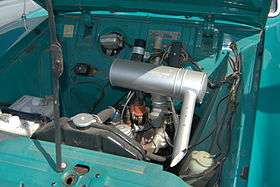Ford Sidevalve engine
| Ford Sidevalve engine | |
|---|---|
 | |
| Overview | |
| Manufacturer | Ford Motor Company |
| Also called | Ford Flathead engine |
| Production | 1932–1962 |
| Combustion chamber | |
| Configuration | Side-valve straight 4 |
| Cylinder block alloy | Iron |
| Cylinder head alloy | Iron |
| Valvetrain | sidevalve |
| Combustion | |
| Fuel system | carburettor |
| Fuel type | Unleaded gasoline |
| Cooling system | Thermosiphon (pump was only fitted after 1953) |
| Output | |
| Power output | 36 BHP |
| Chronology | |
| Predecessor | None |
| Successor |
Ford Kent engine Ford Taunus V4 engine |
The Ford Sidevalve is a side valve (flathead engine) from the British arm of the Ford Motor Company. The engine had its origins in the 1930s Ford Model Y, and were made in two sizes, 933cc or "8 HP", and 1172cc or "10 HP". The early engines were very basic and did not have a waterpump as standard relying on thermo-siphon effect to cool, as the Model T's engine had. A water pump was added in 1953 for the 100E models. The Sidevalve engine was used in many smaller Fords as well as farm vehicles, commercial vehicles and a marine version in boats. Production of the engine was stopped in 1962. Windscreen wipers were often driven by the vacuum generated in the inlet manifold.
The Sidevalve Engine was also used in German Fords, starting with the Ford Köln in 1932 and ending with the last rear wheel drive Ford Taunus 12M in 1962.
It was then replaced by the Kent engine in Britain and by the Taunus V4 engine in Germany.
Engine modifications
Many ways were explored to enhance the power output of the standard engine, most notably special exhaust manifolds, twin carburettors, stiffer valve springs, thinner cylinder head gaskets and modified camshafts. The nominal horsepower quoted for each engine size comes from the British method of power calculation for road taxation purposes, and bears no relationship with the actual power output. Displacement volume, which was calculated from the cylinder diameter, stroke and number of cylinders being the dimensions that determined the power for road taxation purposes.
Gearbox & transmission
A three speed gearbox was fitted as standard; three forward and one reverse. Several ways of improving the performance through modifications to the gearbox and transmission train were applied; replacement close ratio gears fitted to gearbox, overdrive gears fitted behind the original gearbox and higher ratio crown & pinion gears fitted to the differential unit on the back axle.
Use - Ford cars using side-valve engines;
- Ford Model Y (1932–1937),
- Ford C/Ford CX (1934-1937)
- Ford 7W,
- Ford 7Y (1938–1939)
- E93/E493 range
- Ford Anglia (1940–1953),
- Ford Prefect (1938–1953)
- Ford Popular (1953–1959),
- 100E series
- Ford Prefect (1953–1961)
- Ford Anglia (1953–1959)
- Ford Squire (1955–1959)
- Ford Escort a Squire variant.
- Ford Popular (1959-1962)
- Ford Köln (1932–1935),
- Ford Eifel (1935–1939),
- Ford Taunus G93A (1939–1951),
- Ford Taunus 12M first generation (1952–1959),
- Ford Taunus 12M second generation (1959–1962),
Use - Other makers or models using Ford side-valve engines;
- Ashley
- Autobee Pacemaker
- Buckler for their lightweight sports kitcars for road use and rallies, trials, hillclimbs or racing.
- Concordette
- Convair
- Dellow
- Fairthorpe Electron
- Falcon
- Ginetta Cars
- G2
- G3 (aka Fairlite)
- Gregory
- Hud
- Lotus
- Martin
- Mazengrabs
- Morgan
- F4
- 4/4 Series II
- F4/F2
- F Super
- Naco Estate
- Nota
- Paramount
- Rochdale
- C-type
- F-type
- MkVI
- ST
- GT
- Riviera
- Shirley
- Speedex Sirocco GT
- Streamliner
- TVR
- Grantura I
- Tornado
- Typhoon
- Cannon
- Trials Car
Ancillary equipment, designers & other related information
- Aquaplane, manufacturer of dedicated exhaust and inlet manifolds for the Ford sidevalve engine, also aluminium alloy cylinder heads etc.
- Leslie Ballamy, designer of split front suspension used on many "Ford Specials"
- Buckler, manufacturers of 1172 Formula racing cars using a space frame chassis and the 4 cylinder English Ford Sidevalve engine and other Buckler sporting cars using similar equipment. Manufacturer of close ratio gears, special axle ratios, and all types of engine tuning equipment for the 4 cylinder sidevalve engines.
- Willment in the UK, designed and manufactured overhead inlet valve cylinder heads for the side valve engines.
- Elva Engineering in the U.K. designed and manufactured overhead inlet valve conversion cylinder heads for this sidevalve engine, also complete sports/racing cars and other tuning parts.
See also
External links
Bibliography
- Cars and Car Conversions, "Tuning SU Carburetters", Speed and Sports Publications Ltd, (1968).
- G B Wake, "Ford Special Builders Manual", J H Haynes & Co Ltd.
- Philip H. Smith, "The Ford Ten Competition Engine", G T Foulis & Co. Ltd. A complete tuning manual.
- John Haynes, "Building a Fford 10 Special", Auto Publications, London.
- John Mills, "The Constructions of Ford Specials", B T Batsford, London.
- Bill Cooper, "Tuning Side-Valve Fords", Speed and Sports Publications Ltd, (1969).
- Miriam Nyhan, "Are You Still Below", The Collins Press, (2007) - The Ford Marina Plant, Cork, 1917-1984. ISBN 9781905172498
- Ford Motor Company, "Anglia-Prefect Repair Manual"
- Dave Turner, "Ford Popular and the Small Sidevalves", Osprey Publishing Ltd, (1984). ISBN 1-90308-804-6
- Bill Ballard, "English & Australian Small Fords", Ellery Publications, (2002). ISBN 1 876 720 07 7